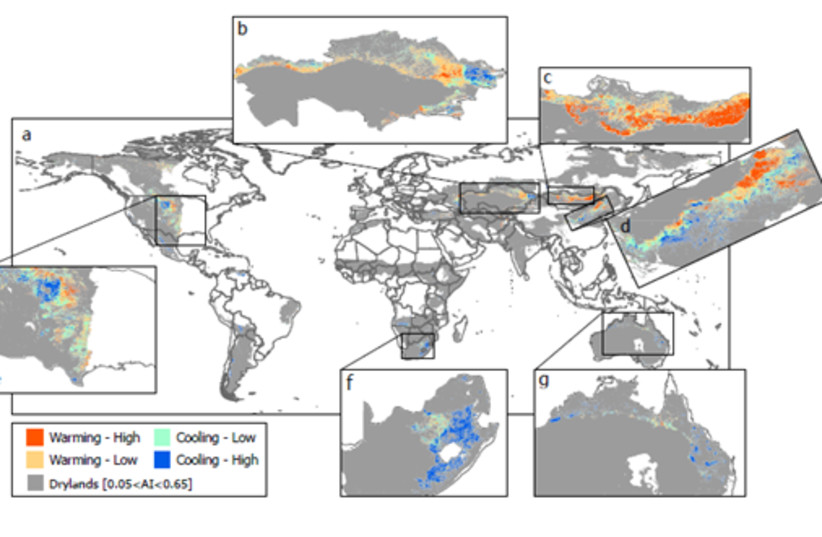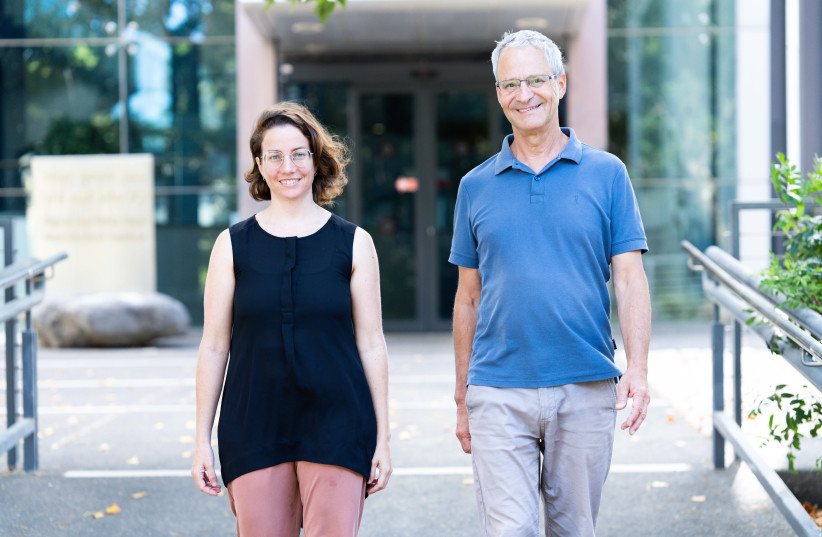Surprising new Israeli research finds that afforestation in semi-dry places may even make global warming worse.
SEPTEMBER 29, 2022 18:52

(photo credit: TECHNION/WEIZMANN INSTITUTE)
The net climatic effect of afforestation of arid areas suitable for planting. In gray – arid areas that are not suitable for planting for various reasons (agricultural areas/urban areas/hot or dry or too cold areas). In red – high heating effect. Yellow – low heating effect. Green – low cooling eff
(photo credit: TECHNION/WEIZMANN INSTITUTE)
Researchers at the Technion-Israel Institute of Technology in Haifa and the Weizmann Institute of Science in Rehovot have found that extensive afforestation of semi-arid areas will not moderate global warming – and it may even make it worse. The researchers developed a smart map showing the potential climatic benefit of planting trees in different sites.
The researchers present in the prestigious journal Science a lengthy study titled “Limited climate change mitigation potential through forestation of the vast dryland regions” on the connection between global warming and planting trees in an area where there was no previous tree cover. Their findings conclude that the semi-arid areas offer the most potential for afforestation, but even though these are huge areas, extensively turning these areas into forests is not necessarily an effective solution to reducing climate warming.
What did their research show?
The research was led by Prof. Yohay Carmel and doctoral student Shani Rohatyn from the Technion’s Faculty of Civil and Environmental Engineering and Prof. Dan Yakir and Dr. Eyal Rotenberg from the department of earth and planetary sciences at the Weizmann Institute
“When we started the research, we thought that we would be able to show that extensive planting of forests in semi-arid areas would significantly slow down climate warming,” said Carmel, “but our study disproved this accepted hypothesis. It is of course disappointing, but this is how science works – it discovers the truth and not what we want to discover. Also, there is an important lesson here: planting forests, no matter how extensive, will not save us from climate change. So, although forestation is clearly important, it cannot substitute for reducing emissions.”
Shani Rohatyn (left) and Prof. Yohay Carmel (credit: NITZAN ZOHAR)
The researchers show in their article that if trees are planted in all locations where forests can be established, their carbon absorption will offset only about 1% of all carbon emissions from the burning of fossil fuels by the end of this century. One of the reasons for the low offset is the fact that in large areas, forestry leads to heating and not cooling due to the “Albedo effect” – the ability that a surface has to reflect light.
For example, the average Albedo effect of the Earth is 0.3. This means that about 30% of the sun’s radiation is reflected back and away from the planet by the earth’s surface. The fact is that darker areas, such as a forest, absorb more radiation than exposed areas such as deserts and glaciers, and therefore increase the heating of the surface in the given area.
The Albedo effect was already known in the context of climate change, but the new study presents for the first time a worldwide mapping of the phenomenon and makes possible intelligent planning of forestry for the first time. In addition, the study included a simulation of the effects of afforestation for the next 80 years – until the end of the 21st century.
Carbon dioxide is the most commonly produced greenhouse gas. Carbon “sequestration” is the process of capturing and storing atmospheric carbon dioxide – one method of reducing the amount of carbon dioxide in the atmosphere with the goal of reducing global climate change.
This region’s carbon sequestration potential until 2100 is 32.3 billion tons of carbon, but 22.6 billion tons of that is required to balance Albedo effects. The net carbon equivalent would offset about one percent of projected medium-emissions and business-as-usual scenarios over the same period, the authors write.
“The climatic consequences of planting forests depend on many factors, including the reflection of local radiation from the soil, the amount of precipitation and the ability of the trees to fix carbon,” said Yakir. “The positive news of our research lies in the tools we developed that make it possible to predict where afforestation can indeed have a positive effect. We hope that planners will take these findings into account and use them for optimal planning of planting trees.”
Rohtyn, who built the model, points out that smart afforestation – that is, planting forests only in climatically correct places based on the current research – is expected to double the absorption rate of carbon from the atmosphere in the new forests and bring it to significant levels at the local and regional level.
The main tool that the researchers developed is a digital map of the Earth that allows the user to focus on the area relevant to him and calculate the potential climatic efficiency of forestry in that area. The researchers hope that this way, planners and decision-makers will be able to promote afforestation in semi-arid areas that will moderate climatic warming and help reduce the concentration of carbon in the atmosphere.
About half of the world’s forestry potential is located in semi-arid areas, and today, large-scale plantings are already underway in China, Saudi Arabia, the Sahel – the vast region of Africa separating the Sahara Desert to the north and tropical savannas to the south – and other areas. These projects are expected to transform about five million square kilometers from a barren area into forest. The current research shows that without proper planning, these projects are liable to create undesirable climatic results, so it is important to conduct site-focused planning of planting in semi-arid areas.
“Afforestation is a process that has many advantages, including the preservation of sediment, local cooling, prevention of soil erosion and more,” concluded Carmel. “However, uncontrolled afforestation may destroy rare species adapted to life in the open desert and thus harm biological diversity and, as mentioned, also harm the great goal of minimizing climate warming. That is why it is so important to take into account all the considerations before starting the wholesale afforestation of large areas.”
https://www.jpost.com/environment-and-climate-change/article-718368

